Propagating Chinese money plants is a practically foolproof endeavor. If ever there was a plant that screams propagate me it’s Pilea peperomioides. These popular houseplants are vigorous growers, producing many offshoots that are easily rooted and transplanted. The nicknames friendship plant and pass along plant speak to the ease of its propagation.
To allay any lingering qualms regarding your ability to successfully propagate a Chinese money plant, dig this: Agnar Espegren, the Norwegian missionary who introduced the Chinese money plant to the Western world, left his specimen unattended in his luggage. For a year. Yep, you read that correctly. On the way back to Norway from China, the family spent a year in Calcutta, India. Legend has it that returning to Norway, Espegren discovered the forgotten plant in his luggage still alive!
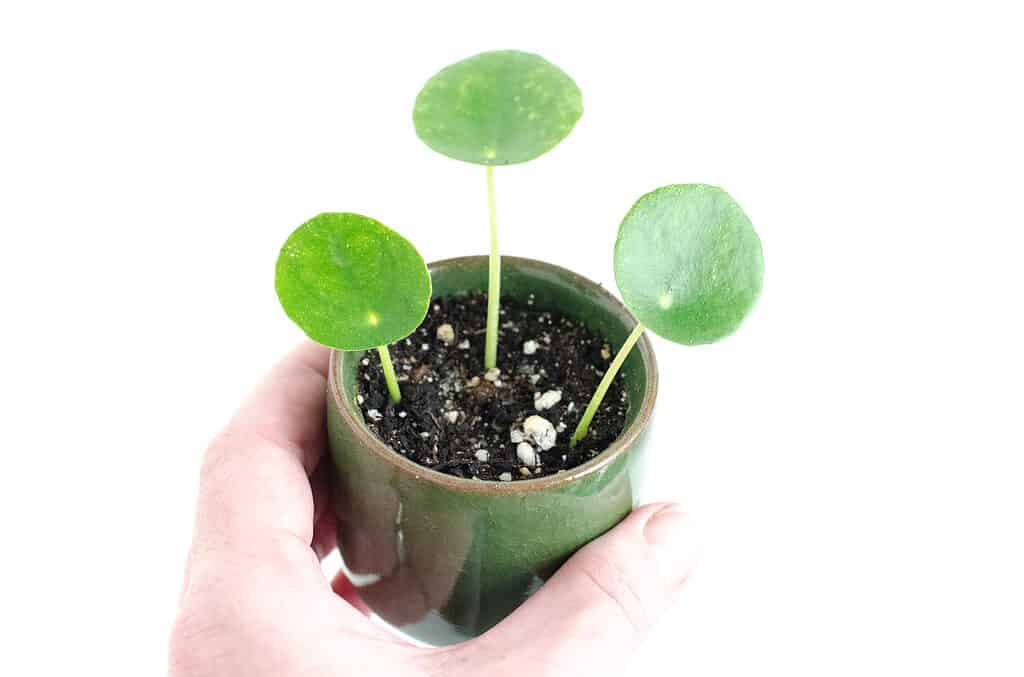
The nicknames friendship plant and pass along plant speak to the ease of its propagation.
©Pegasene/Shutterstock.com
He planted it in the soil. Noticing the offshoots that appeared around the plant’s base, he propagated them. Espergren shared the propagated plants with folks he met in his travels as a missionary. And, like a bad rumor, the plant spread across Europe, making its way to the shore of North America in the mid-to-late 20th century. Keep reading to learn everything you need to know for successful Chinese money plant propagation in this how-to guide.
Chinese Money Plant Propagation: Preparation
Propagation is an action that encourages the spread or increases the number of already existing organisms. Chinese money plants are excellent propagators, thanks to their habit of producing offshoots. These offshoots, clones of the original plant, pop up around the plant’s base. One plant produces dozens of offshoots at a time. Each offshoot is capable of producing a plant in its own right.
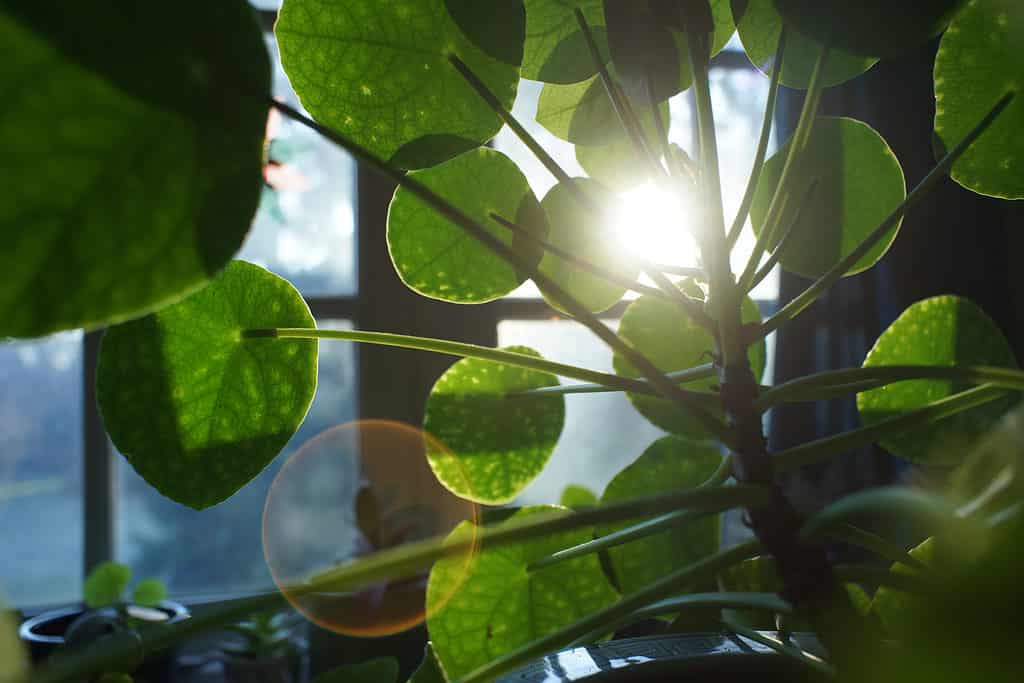
Each offshoot is capable of producing a plant in its own right.
©Floris Verweij/Shutterstock.com
Propagating Chinese money plants is a very straightforward process, with a couple of different methods. Gathering the materials and supplies you will need is the first step to successful propagation. Regardless of which method you choose to propagate your Chinese money plant, you will need some or all of the following:
- a Chinese money plant with several offshoots
- a shape, sterile blade
- potting soil
- small plastic or terra cotta containers
- glass bottles with narrow tops
- rooting hormone
- water
Chinese Money Plant Propagation: Choosing a Method
Though there are many reasons for propagating a Chinese money plant, one of the most common is overcrowding. Chinese money plants, given proper care, can be quite prolific. Overcrowding adversely affects the host plant. Removing offshoots is the quickest and most effective way to restore the plant to health. It’s time to start propagating once you notice the mother plant producing offshoots. So which method of propagation should you choose? Propagation of this popular ornamental plant is accomplished in a couple of different ways. However, one method is distinctly easier and meets with more success than the other.
Propagation By Division
The easiest method by which to Propagate Chinese money plants is by division. It is also the most successful method. In the case of a Chinese money plant, propagation by division is accomplished by removing an offshoot (or offshoots) from the soil around the original plant. This can be done in two different ways.
One way is by working your fingers gently into the soil around an offshoot. The offshoot is connected to the original plant by rhizomes. Rhizomes are underground stems that send out runners from which new plants grow. Slender roots, no thicker than a hair, keep the offshoots anchored in place, but it’s the rhizome that gives the plant life. Mature, well-established offshoots may require cutting with a shape, sterile blade to free the rhizome from the host. Once removed, place the offshoot in a long-necked bottle of water, allowing its rhizome to develop prior to transplanting it into a container with soil. Planting the offshoots directly into the soil is another option. However, planting an offshoot directly into the soil requires a bit of extra care on the front end.
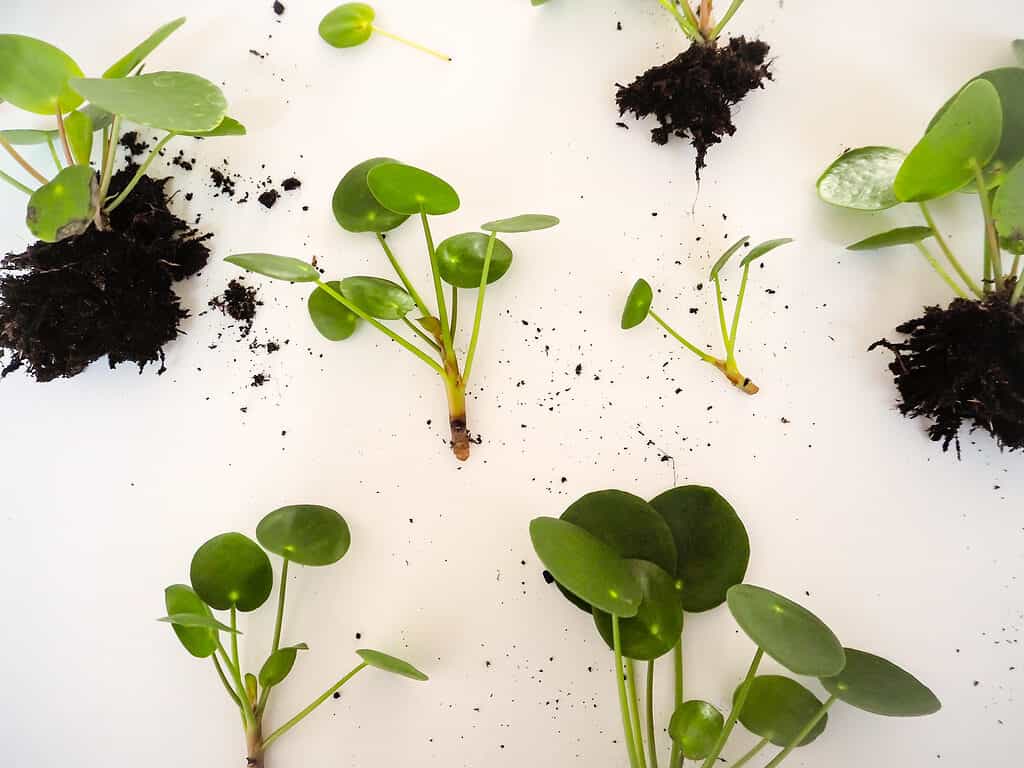
Propagation by division is accomplished by removing an offshoot (or offshoots) from the soil around the original plant.
©Luoxi/Shutterstock.com
Chinese Money Plant Propagation: Division in Soil
A Chinese money plant offshoot immediately transplanted into soil requires a fair amount of attention for several weeks afterward. Propagation by division in soil involves planting the offshoot directly into a container of potting soil. Perlite-containing organic mixes are recommended and are widely available commercially. Perlite, a siliceous rock, aids germination and rooting by keeping the soil evenly moist. Plant the offshoot’s rhizome 1-2 inches deep into the soil, being certain to tamp down the soil around the offshoot’s base to help anchor its rhizome.

Plant the offshoot’s rhizome 1-2 inches deep into the soil, being certain to tamp down the soil around the offshoot’s base to help anchor its rhizome.
©Luoxi/Shutterstock.com
For the next 3-4 weeks it is imperative that the soil is kept damp. The newly planted offshoot does not have a well-developed or deep root system. Therefore, when the soil is dry to the touch, it’s time to water. Once the offshoot has had time to establish roots, a less frequent watering schedule is incorporated. Offshoots propagated by the direct soil method tend to mature more quickly than their division in water counterparts. The extra attention provided on the front end pays off on the back end.
Chinese Money Plant Propagation: Division in Water
A Chinese money plant offshoot started in water is allowed the time to develop a stronger rhizome, requiring less care once it’s planted. Filling a longneck or similarly narrow top bottle with water, place the rhizome of the offshoot into the water, leaving the leaves and steam above the water. The direct division in water is the most successful means of Chinese money plant propagation. However, it takes time for the rhizome to develop roots. Roots will appear as slender, white hairs growing out of the rhizome. After several weeks when the roots are well-developed, it’s time to transplant the offshoot into the soil. As with the direct-to-soil method, be certain to anchor the roots into the soil. Though they will not grow as vigorously as those grown in soil, offshoots can be left rooting in water indefinitely.
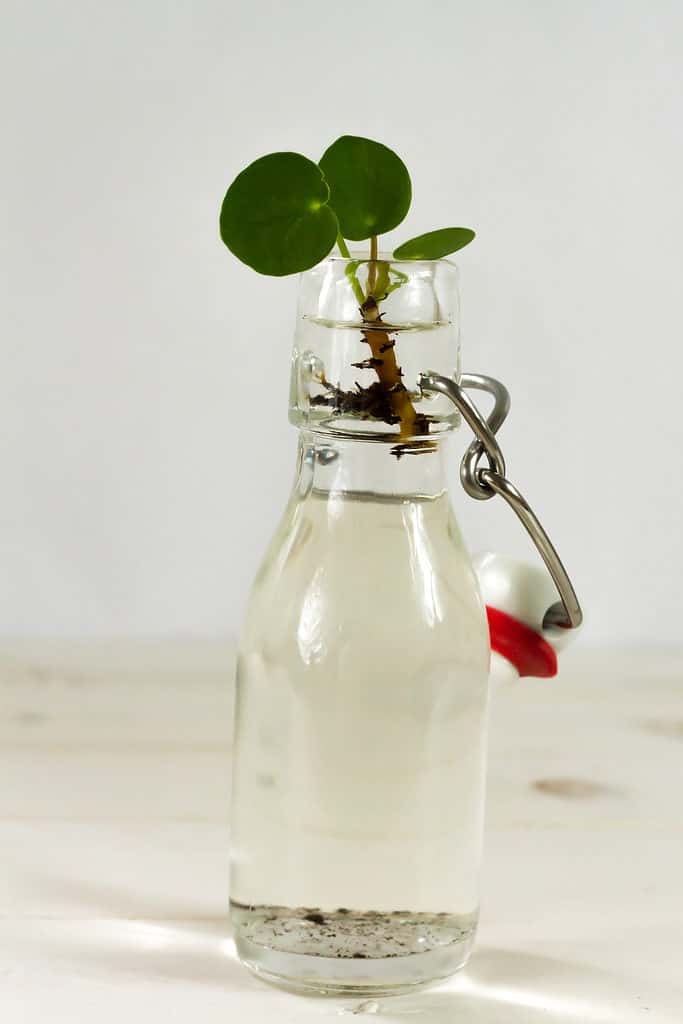
Filling a longneck or similarly narrow top bottle with water, place the rhizome of the offshoot into the water, leaving the leaves and steam above the water.
©Patrycja Nowak/Shutterstock.com
Chinese Money Plant Propagation: Propagation by Leaf Cutting
Taking leaf cuttings from an established plant is another way of propagating a Chinese money plant. Using a sharp, sterile blade, separate one leaf from the plant at the base, removing a bit of the base of the host. Place the cutting into a longneck or similar bottle submerging the stem in water, while keeping the leaf dry.
Slender, white roots will begin to appear in a matter of weeks. A few weeks after the roots first appear, an offshoot should be visible, growing on the roots of the submerged stem. The leaf cutting will begin to die once the offshoot appears. This is natural. Once the offshoot is its own viable organism, it no longer requires the leaf cutting to live. When the offshoot’s roots are an inch long, it is ready to be transplanted into a container with potting soil.
When a rooting hormone is used, leaf cuttings may be transplanted directly into the soil. Though there are plants that require this method of propagation, the Chinese money plant is not one of them. With other, more successful, and accessible methods available, using a rooting hormone on a leaf cutting isn’t recommended.
Chinese Money Plant Propagation: Main Stem Propagation
Generally employed as a means of reducing the size of a mature Chinese money plant, main stem propagation is yet another method. In main stem propagation, the sharp, sterile blade cuts the existing plant off at its base. The host plant is not sacrificed, and will slowly produce new growth and offshoots. The main stem cutting may be propagated in water or soil, like the offshoots above. However, the amount of time increases proportionally to the size of the main stem cutting.
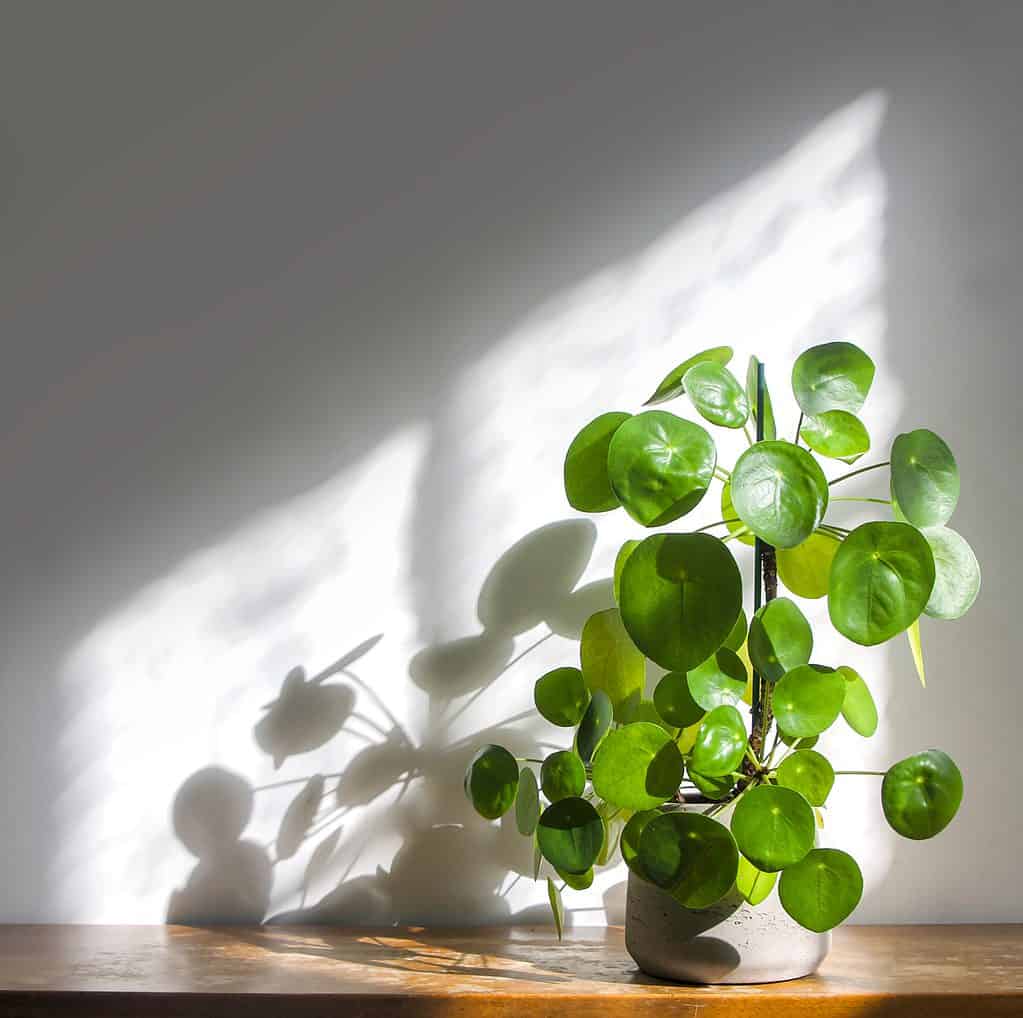
Generally employed as a means of reducing the size of a mature Chinese money plant, main stem propagation is yet another method.
©Kulbir G/Shutterstock.com
Whether you choose to take the easy way, propagating your Chinese money plant by division, or taking the road less traveled, propagating your Chinese money plant from a leaf cutting or main stem propagation, chances are you’ll be successful. Agnar Espegren, after all, left his plant unattended for a year and he was still able to spread it throughout the world! Want to know more about your Chinese money plant? Click here!
The photo featured at the top of this post is © Mehta Photography/Shutterstock.com
Sources
- thespruce, Available here: https://www.thespruce.com/growing-pilea-peperomioides-5090425
- gardenbetty.com, Available here: https://www.gardenbetty.com/pilea-peperomioides-chinese-money-plant/
- mytastefulspace.com, Available here: https://blog.mytastefulspace.com/2021/10/25/chinese-money-plant/
Thank you for reading! Have some feedback for us? Contact the AZ Animals editorial team.






